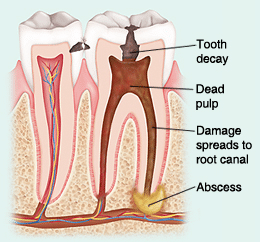Choosing Root Canal Therapy
Root canal therapy can save a tooth whose pulp has died. The earlier the tooth is treated, the less pain, trouble, and expense you'll face. And though many people believe that root canal therapy is painful, this is just a myth: The treatment rarely causes discomfort.
An Overview of Treatment
Root canal therapy consists of removing the inflamed or infected pulp. The first step is to make an opening in the crown. The dentist then cleans the pulp chamber and root canals. These spaces are later filled with a rubber-like substance called gutta-percha, which acts as a permanent bandage. Finally, restoring the crown of the tooth protects the tooth from further damage or infection. The goals of treatment are to:
- Relieve pain and other symptoms.
- Stop any infection and prevent its spread.
- Save the tooth from having to be extracted.
Risks and Complications
Root canal therapy has a high rate of success. If complications do occur, they are often minor and can be treated. Risks and possible complications include:
- Pain or infection
- Reaction to medication or anesthesia
- Sore jaw joint and surrounding muscles
- Separated (broken) instrument
- Need for additional treatment, such as endodontic surgery
Glick & Woods Dentistry is Tullahoma’s most popular dental experience since 1985. Please call us at 931.455.3917 or fill out our online Request an Appointment form to arrange your consultation.














